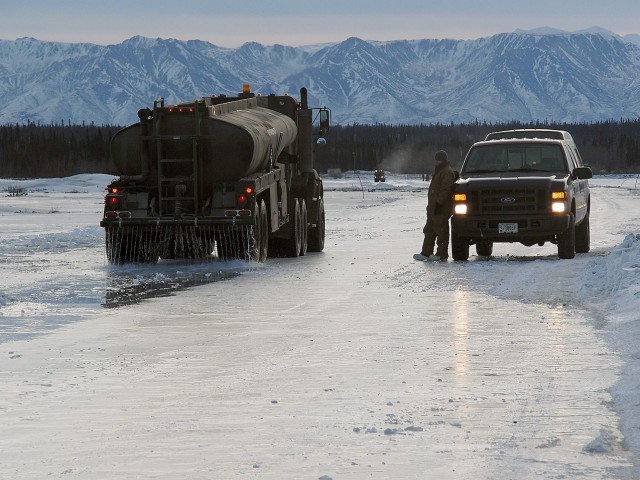The U.S. Army Cold Regions Test Center has 50 employees on a permanent, full time basis. Managing the resources in an organization that size becomes a challenge at times, especially when the cold test season runs only from October through March. With more than 15 tests this winter, resources are spread thin and test officers must plan to make sure the resources they need are available when they need them.
Last winter Dave Hoffman, a test officer at CRTC, was in charge of building a combination ice bridge and ice road over the Delta River. The Delta is a braided river, consisting of a few main channels, several smaller channels, and temporary islands in between. The channels split off and rejoin each other, giving it a braided appearance.
Hoffman had a three-person team working around the clock building and maintaining an ice bridge/road, but this year, with a busier test season, those individuals, including Hoffman, were not going to be available on a full-time basis. John Viggato, the test officer for the Non-Line of Sight-Launch System, needed to find another way to get the job done.
An ice bridge/road would be essential for his test, allowing access to remote test sites. Viggato began talking with the 6th Engineers out of Fort Richardson, Alaska, during the summer to see if they were interested in a unique support and training opportunity. Building an ice bridge/road would offer them hands-on training they would otherwise not receive. The engineers jumped at the opportunity and on Nov. 9, 2009, members of the 84th Engineering Support Company Airborne and the 56th Vertical Engineers arrived at CRTC.
2nd Lt. William Byrd with the 84th ESC saw this opportunity as "something most Soldiers at Fort Richardson and in the Army will not get to see or do."
Hoffman, who became a very knowledgeable on ice bridge/road building last winter, was tasked with being an advisor to the engineers. He would be able to offer invaluable guidance to the Soldiers, who had no real experience building an ice bridge/road.
"Working with the Soldiers was a pleasure," Hoffman said. "I enjoyed being able to teach them something that makes them more mission capable and better Soldiers."
Byrd's first thoughts when Hoffman took him to location on the Delta River where the ice bridge/road would be built was the "unknowingness of the ice-I felt like I was fixing to fall through any minute."
Cpl. Alan Gordon, a member of the 56th Vertical Engineers, felt the same way, but actually experienced this during his first trip to the ice bridge/road. He was getting a tour of the ice bridge/road from Hoffman in a Small Unit Support Vehicle (SUSV) when "the SUSV suddenly fell through the ice and there was water covering the tracks." Hoffman knew from experience and reconnaissance work that the ice was not frozen all the way down and at some point the SUSV would likely break through the ice, but Gordon did not and immediately knew this was going to be an exciting "opportunity and experience."
Throughout the next few months, the engineers worked on the mile-long ice bridge/road. Two crews of 11 Soldiers rotated through every 10 days, allowing for continuous work.
"The biggest obstacle we ran into was nature; it became a big factor, both helping and hurting," Byrd said.
When the temperatures were extreme in either direction, there would be water running over the ice bridge/road and the Soldiers would have to wait for the overflow to refreeze. One thing Hoffman had a hard time making the engineers realize was "there are times when you have to sit back and let Mother Nature do her thing, and then you go in afterwards and clean up the mess."
The engineers experienced this with the fluctuating temperatures and overflow.
Building an ice bridge/road takes a lot of time, hard work and favorable weather conditions. The water must be frozen down to the riverbed, which requires breaking the ice down to the bottom and allowing it to freeze from the bottom up. The Engineers had to pump thousands of gallons of water onto the bridge/road to get the ice thick enough to support heavy equipment, while at the same time smoothing it out so vehicles could drive across it easily.
After a lot of hard work, patience and cooperation from Mother Nature the engineers established an ice bridge/road that was 28 inches thick in the beginning of January. With work scheduled to continue through the end of February, the engineers will add another 2.5 inches of ice every day.
The thickness of the ice was crucial; in the middle of January, CRTC drove one tank, two personnel carriers, a D-9 bulldozer, and an M88 across the ice bridge/road. The M88, an armored recovery vehicle, weighs 56 tons.
In addition to the large vehicles driven across the bridge/road, personnel and equipment were transported to remote test sites daily via the ice bridge/road.
Viggato knew the importance.
"The ice bridge/road was a key element in test execution," he said. "Every piece of equipment used in the NLOS-LS firing at CRTC, from pens and pencils to tanks and bulldozers, was crossed over the bridge/road.
The 6th Engineers provided CRTC with essential support during a critical test mission. Their capability and dedication allowed CRTC to complete the NLOS-LS mission successfully and without the additional burden of ice bridge/road construction and maintenance on top of an already overloaded support division."


Social Sharing